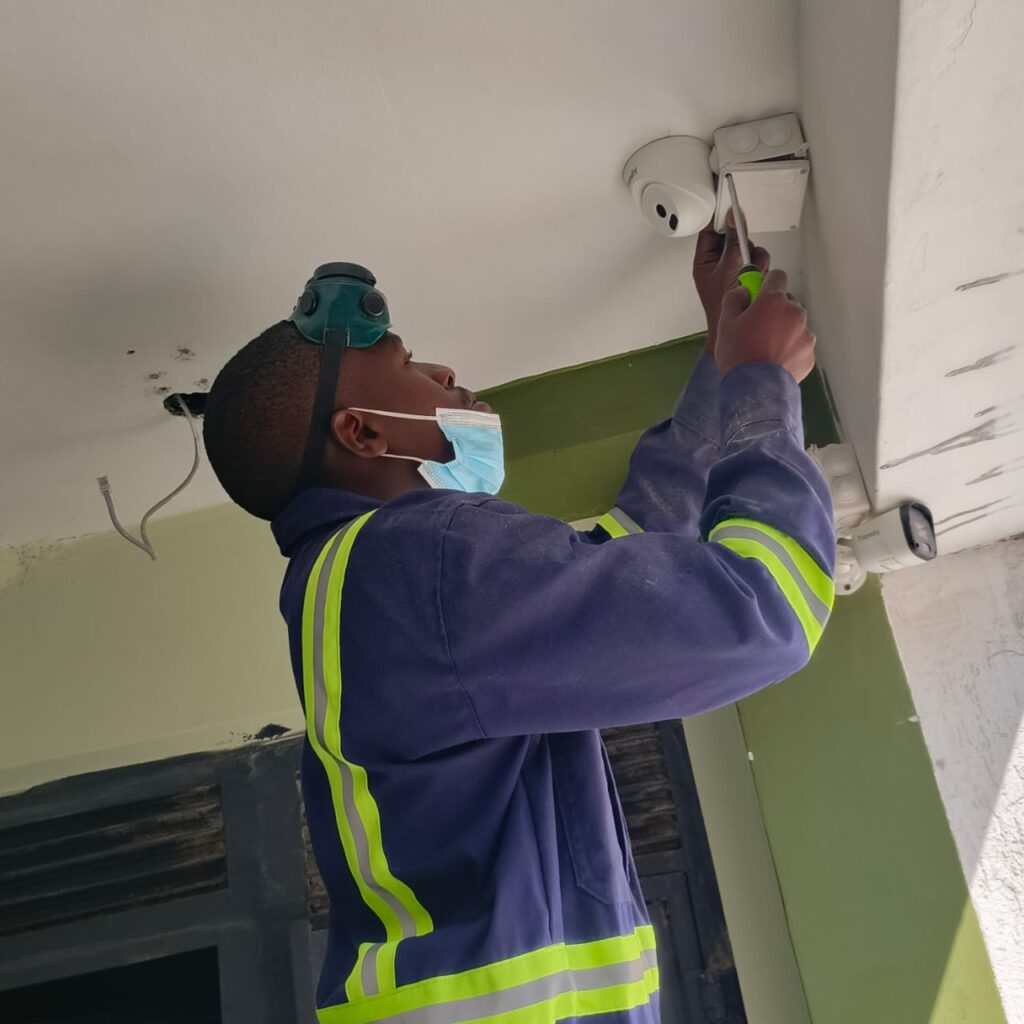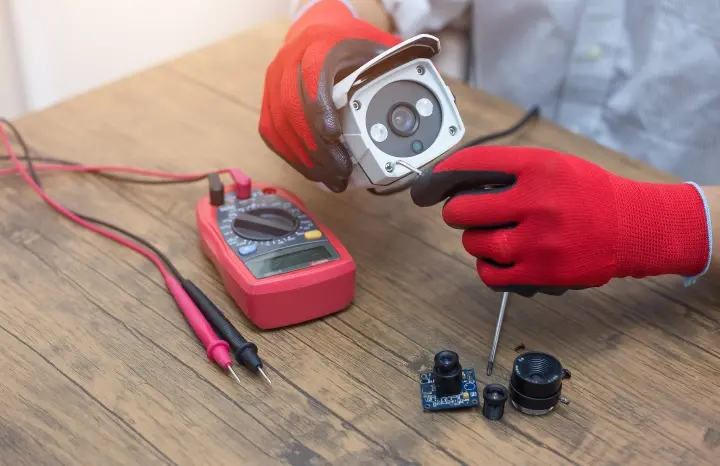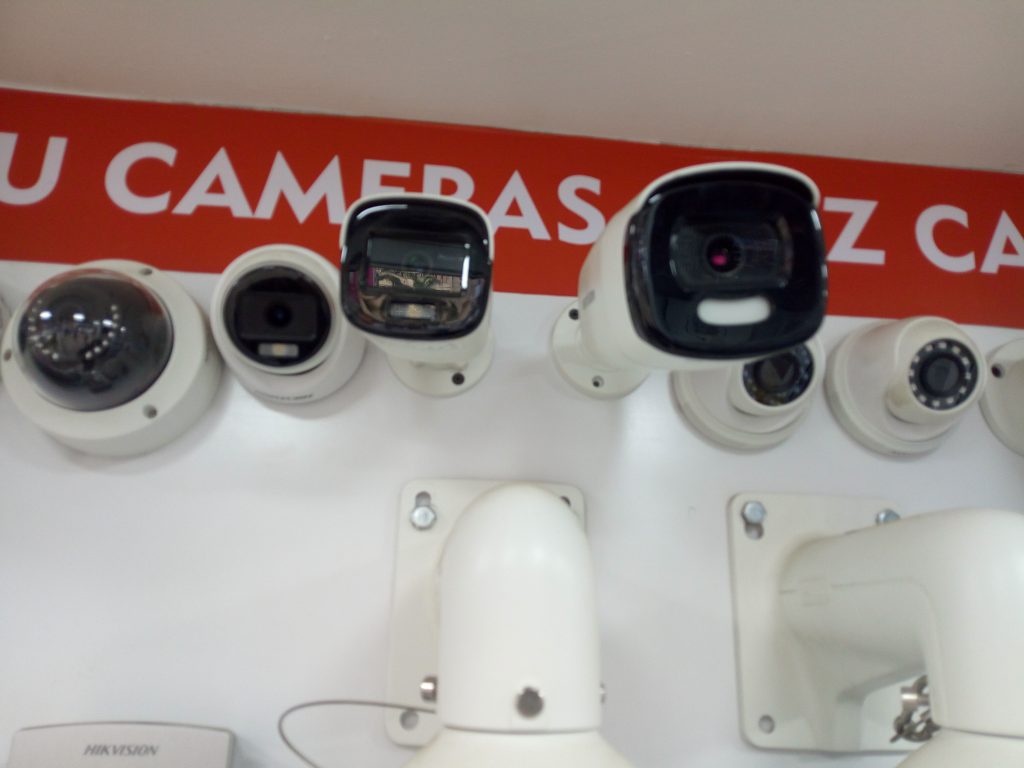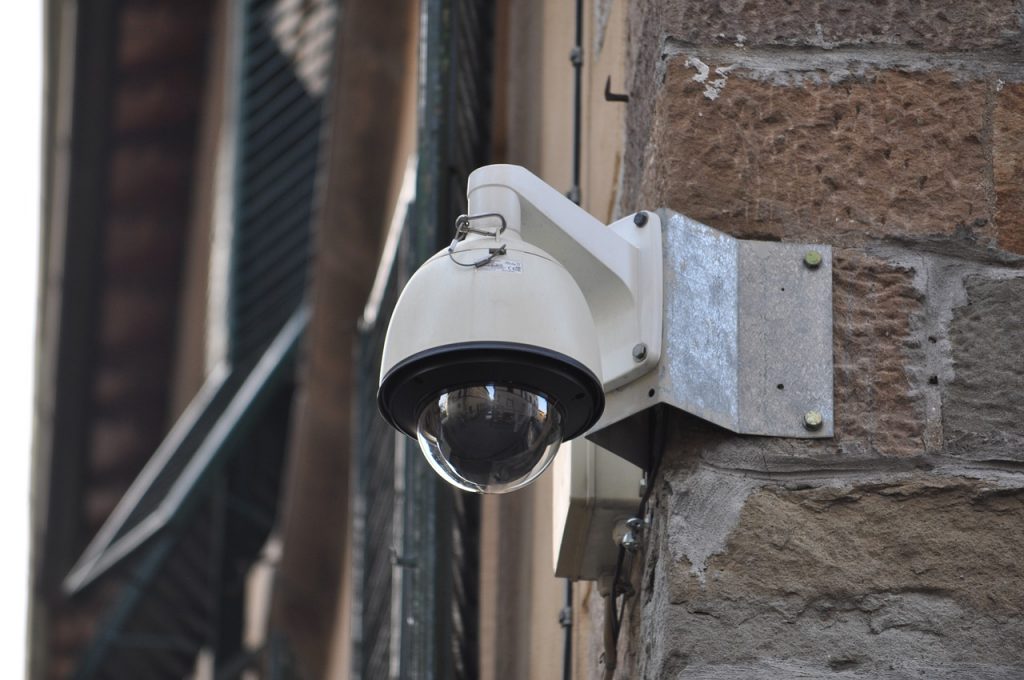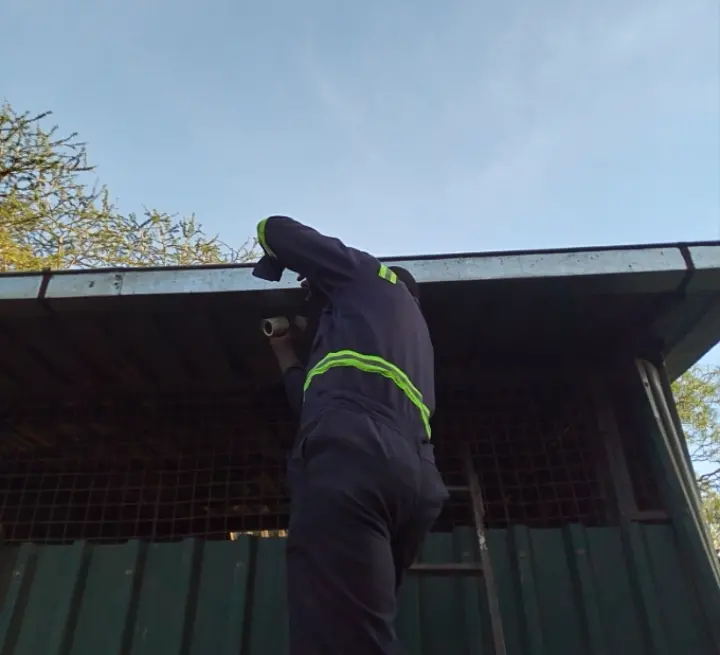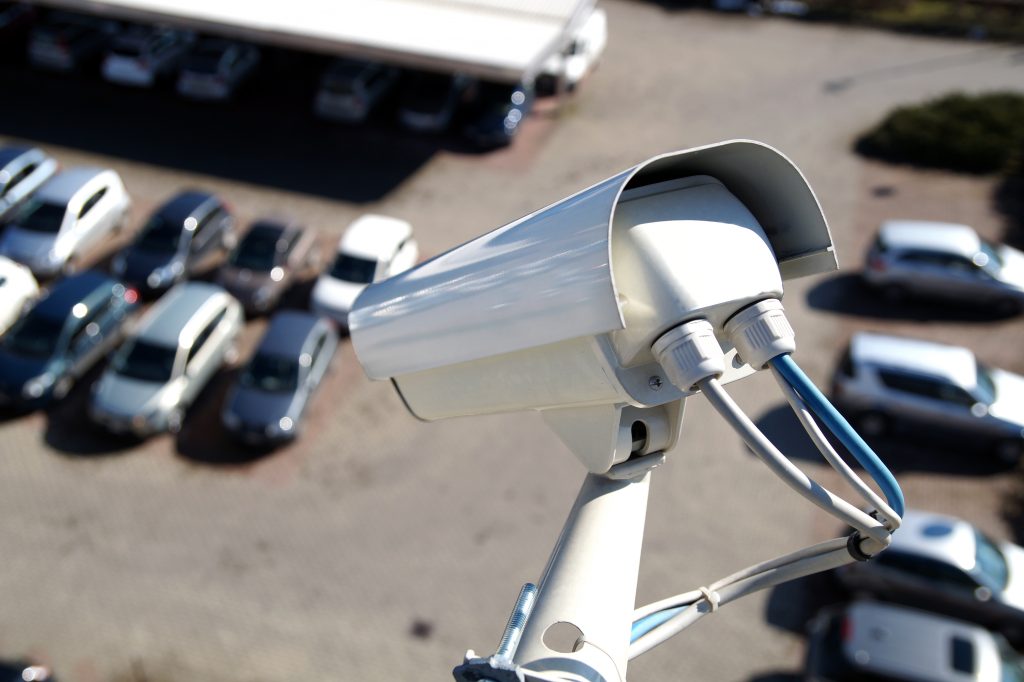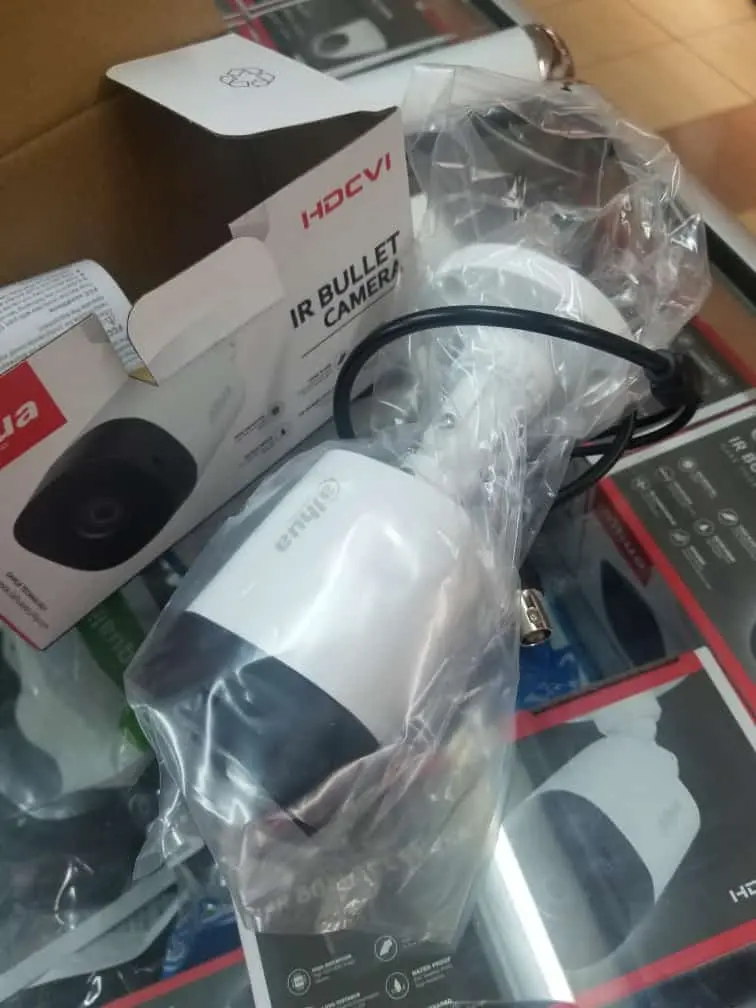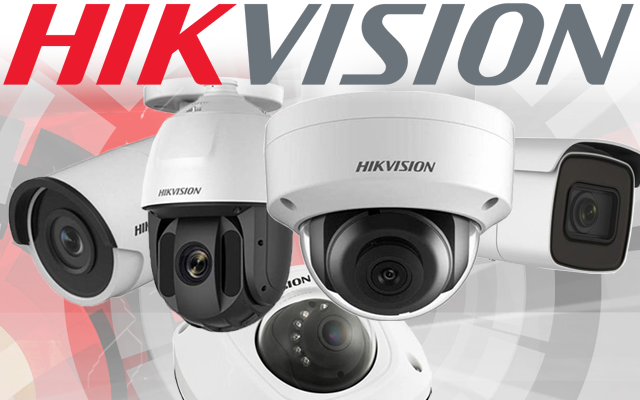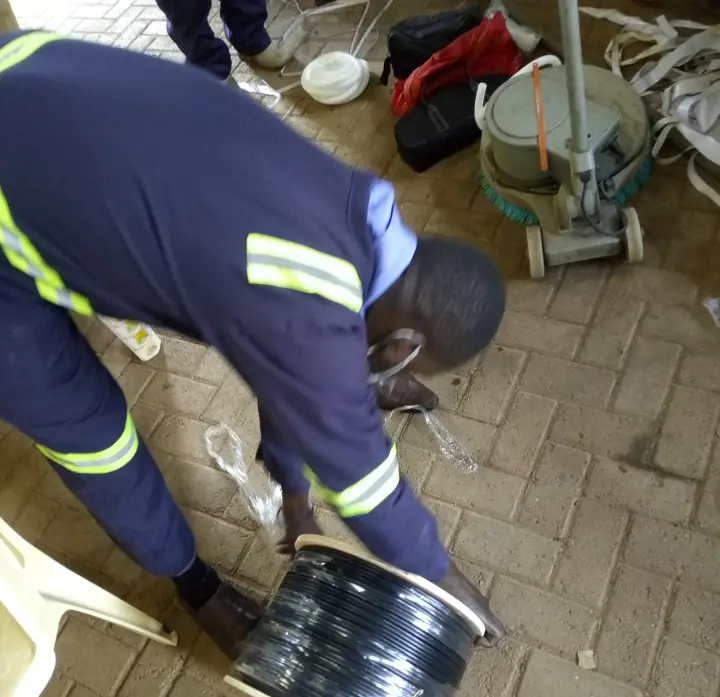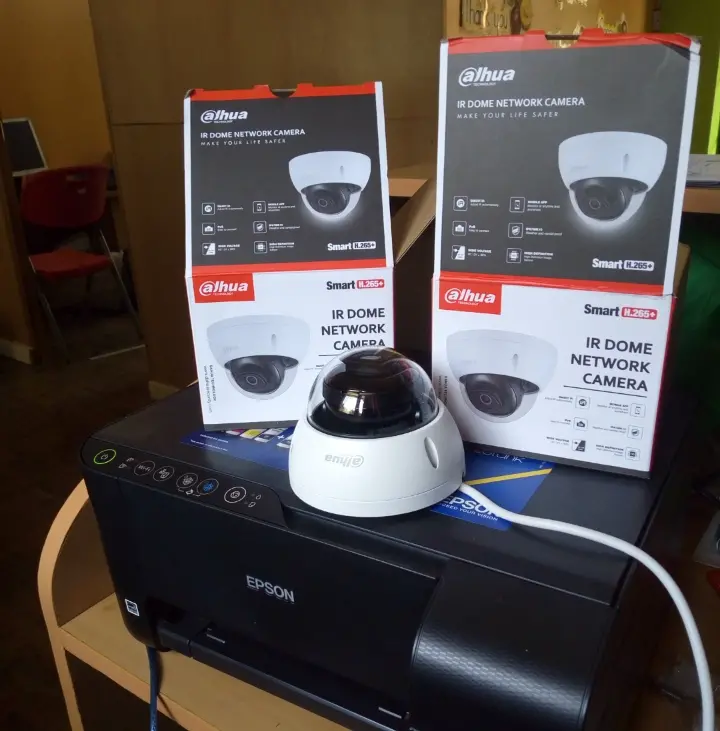What is a CCTV camera, and how does it work?
FAQS About CCTV Cameras. A CCTV (Closed-Circuit Television) camera is a security device that captures and transmits video footage to a limited set of monitors or recording systems. Unlike broadcast television, CCTV operates on a closed network, making it ideal for surveillance. These cameras work by capturing video through a lens, converting it into an electronic signal (analog or digital), and transmitting it to a DVR (Digital Video Recorder) or NVR (Network Video Recorder) for storage and playback.
Modern IP cameras digitize footage at the source, while analog CCTV cameras require a DVR for conversion. Many CCTV systems include night vision (IR LEDs), motion detection, and remote access via smartphones. The footage can be stored on hard drives or cloud storage, ensuring security monitoring in real-time or for later review.
CCTV cameras are widely used in homes, businesses, banks, and public spaces for crime prevention and evidence collection. They can be wired (using coaxial or Ethernet cables) or wireless (Wi-Fi-based), depending on the setup. Advanced models include AI-powered features like facial recognition and license plate detection for enhanced security.
CCTV camera, DVR, NVR, IP cameras, night vision, motion detection, wireless CCTV, surveillance, security monitoring.
What are the different types of CCTV cameras available?
There are several types of CCTV cameras, each designed for specific surveillance needs. Dome cameras are common in indoor spaces due to their discreet design, while bullet cameras are weatherproof and ideal for outdoor use. PTZ (Pan-Tilt-Zoom) cameras offer remote control for tracking movement, making them suitable for large areas like parking lots.
For low-light conditions, infrared (IR) cameras with night vision are essential, while thermal cameras detect heat signatures in complete darkness. Wireless IP cameras provide flexible installation with Wi-Fi connectivity, whereas analog CCTV cameras are more affordable but require coaxial cables. Hidden or spy cameras are used for covert surveillance but must comply with privacy laws.
Businesses often use fisheye cameras for 360-degree coverage, while ANPR (Automatic Number Plate Recognition) cameras are used in traffic monitoring. The choice depends on factors like resolution (1080p, 4K), storage needs, and environmental conditions.
Dome cameras, bullet cameras, PTZ cameras, infrared CCTV, wireless IP cameras, analog CCTV, fisheye cameras, ANPR, surveillance cameras.
3. What is the difference between analog and IP cameras?
Analog CCTV cameras transmit video signals over coaxial cables to a DVR, which processes and stores footage. They are cost-effective but offer lower resolution (typically 720p or 1080p) compared to IP cameras. Analog systems are easier to set up for small-scale surveillance but lack advanced features like remote analytics.
IP (Internet Protocol) cameras, on the other hand, digitize footage at the source and transmit it via Ethernet cables or Wi-Fi to an NVR. They support higher resolutions (4K, 8MP) and advanced functionalities like AI-based motion detection, two-way audio, and cloud storage. IP cameras also allow remote access via smartphones, making them ideal for modern security needs.
While analog systems are cheaper, IP cameras offer better scalability, encryption, and integration with smart home systems. However, IP cameras require a stable network and more bandwidth. Businesses often prefer IP surveillance for high-security areas, while analog may suffice for basic home monitoring.
Analog CCTV, IP cameras, DVR vs. NVR, 4K resolution, remote access, AI surveillance, smart home security, Ethernet vs. coaxial.
What is the best CCTV camera for home use?
The best CCTV camera for home use depends on security needs, budget, and installation preferences. Wireless IP cameras like Hikvision, Dahua, or TP-Link Tapo are popular due to easy setup, 1080p/4K resolution, and smartphone integration. Features like two-way audio, motion alerts, and night vision enhance home security.
For outdoor surveillance, bullet or dome cameras with weatherproof (IP66/IP67) ratings are ideal. Budget-friendly options include analog HD-TVI cameras, while smart homes benefit from Google Nest or Arlo cameras with cloud storage. Battery-powered cameras like Eufy are great for renters or temporary setups.
Key considerations include storage (local vs. cloud), power source (wired vs. solar), and smart integrations (Alexa/Google Assistant). A 4-camera system with a 1TB DVR is sufficient for most homes, covering entry points like doors, garages, and backyards.
Best home CCTV, wireless IP cameras, night vision, motion alerts, Hikvision, Google Nest, Arlo, weatherproof cameras, smart home security.
What is the best CCTV camera for business/commercial use?
For business CCTV systems, high-resolution IP cameras (4K, 8MP) with AI analytics (facial recognition, crowd detection) are recommended. Brands like Hikvision, Dahua, and Axis offer PTZ cameras for large warehouses, while fisheye cameras provide 360° coverage in retail stores.
PoE (Power over Ethernet) cameras simplify wiring, while thermal cameras enhance perimeter security. A 16-channel NVR with 4TB storage ensures long-term recording, and cloud backups prevent data loss. ANPR cameras help monitor vehicle entries in parking lots.
For 24/7 surveillance, IR night vision (up to 30m range) and vandal-proof housing are essential. Restaurants, banks, and offices benefit from audio recording (where legal) and remote monitoring via mobile apps.
Business CCTV, IP cameras, AI analytics, PoE cameras, thermal imaging, ANPR, NVR storage, remote monitoring, commercial security.
How much does a CCTV camera system cost in Kenya?
The cost of CCTV cameras in Kenya varies significantly based on system type, brand, and features. A basic 2-camera analog system with a DVR starts from KSh 15,000, while a 4-camera HD-TVI system ranges between KSh 25,000-40,000. For higher-end solutions, IP camera systems (4 cameras with NVR) cost KSh 50,000-100,000+, depending on resolution (4K/8MP) and smart features like facial recognition.
Professional installation adds KSh 5,000-15,000, while advanced systems with PTZ cameras, thermal imaging, or enterprise-grade analytics can exceed KSh 200,000. Monthly cloud storage subscriptions (for IP cameras) cost KSh 500-3,000 based on storage capacity. Popular brands like Hikvision, Dahua, and Uniview offer different price tiers, with local dealers providing warranties.
Budget-friendly wireless options like TP-Link Tapo or Xiaomi (KSh 6,000-15,000 per camera) are ideal for homes, while businesses investing in PoE (Power over Ethernet) systems should factor in cabling and switch costs. Government taxes and import duties also affect final pricing.
CCTV cost Kenya, Hikvision prices, IP camera system, cloud storage, PoE cameras, HD-TVI, installation fees, surveillance budget.
Can CCTV cameras work without electricity?
CCTV cameras typically require power sources, but solutions exist for power outages. Battery-powered cameras (e.g., Arlo, Eufy) operate for 3-6 months per charge, while solar-powered CCTV (with panels) offers renewable energy. For wired systems, a UPS (Uninterruptible Power Supply) or backup generator keeps DVR/NVR running during blackouts.
PoE (Power over Ethernet) cameras draw power from network cables but still need a PoE switch/injector with backup power. Some hybrid systems use 12V DC batteries as fail-safes. However, infrared (IR) night vision and heating elements in outdoor cameras consume more energy, reducing battery life.
For 24/7 surveillance, hardwired cameras with UPS support are most reliable. Wireless options sacrifice some features (e.g., continuous recording) for power independence. Always check voltage requirements (12V/24V/48V) and weather resistance for outdoor setups.
Battery CCTV, solar cameras, UPS backup, PoE power, wireless surveillance, IR night vision, power outage solutions.
Do CCTV cameras work at night?
Most modern CCTV cameras feature night vision using infrared (IR) LEDs or low-light image sensors. IR cameras emit invisible light (wavelengths 850nm-940nm) to illuminate scenes, providing black-and-white footage in pitch darkness. The range varies (20m-50m)—high-end models like Dahua Starlight or Hikvision DarkFighter extend beyond 100m.
For color night vision, full-color sensors (e.g., Sony Starvis) or ambient light-dependent cameras are used. Thermal cameras detect heat signatures, working in zero-light conditions but producing monochrome images. Performance depends on lens aperture (f/1.0-f/2.0), sensor size, and IR intensity.
Limitations include overexposure from nearby lights or reflective surfaces. Some cameras switch to B/W mode automatically at night. For optimal results, avoid pointing cameras at glass/walls and ensure IR LEDs aren’t obstructed by spider webs or dirt.
Night vision CCTV, IR cameras, thermal imaging, Starlight sensors, low-light surveillance, infrared range, color night vision.
How far can CCTV cameras see at night?
The night vision range depends on camera type, IR power, and lens focal length. Standard bullet cameras with 30-50 IR LEDs cover 20-30 meters, while long-range IR models (e.g., Hikvision DS-2CD2043G0-I) reach 50-100m. PTZ cameras with auto-focus and varifocal lenses adjust dynamically for clearer long-distance imaging.
Thermal cameras detect objects up to 1km away but lack detail (e.g., facial recognition). For extended ranges, external IR illuminators can boost visibility. Note that resolution drops at maximum range—a 4MP camera may only deliver 480p clarity beyond 50m due to digital noise.
Environmental factors like fog, rain, or dust reduce effective distance. For perimeter security, stack multiple cameras or use laser IR illuminators (500m+ range). Always check lux rating (0.001 lux for true low-light performance) when purchasing.
IR distance, thermal CCTV, varifocal lens, lux rating, laser illuminators, night vision range, long-range surveillance.
Can CCTV cameras record audio?
Yes, audio recording is possible with built-in microphones or external audio input (3.5mm jack). Many IP cameras (e.g., Reolink RLC-822A) support two-way audio, enabling live communication. However, privacy laws in Kenya and elsewhere may require consent notices for audio surveillance in public/private spaces.
Analog cameras need a separate audio cable connected to the DVR. Audio quality varies—wide-dynamic microphones reduce background noise, while AI-enhanced systems can isolate specific sounds (e.g., glass breaking). Storage considerations: 1-hour audio ≈ 5MB of space.
Legal risks include eavesdropping violations under Kenya’s Data Protection Act (2019). Mute audio in sensitive areas (bathrooms, changing rooms). For businesses, post “Audio Recording in Progress” signs to comply with regulations.
Audio CCTV, two-way audio, privacy laws, microphones, Data Protection Act, eavesdropping, sound recording.
Installation & Setup
How do I install a CCTV camera at home?
DIY CCTV installation involves planning camera positions, running cables, and configuring the recorder. For wired systems, mount cameras (using brackets) at entry points, drill holes for RG59 coaxial/Siamese cables, and connect to the DVR’s BNC ports. Use weatherproof conduit for outdoor wiring to prevent damage.
Wireless IP cameras simplify setup—just power them via outlet or PoE, sync with the app (e.g., Hik-Connect), and adjust angles. Ensure the Wi-Fi signal is strong (use mesh extenders if needed). For hardwired power, a 12V DC adapter is typical, with cables hidden in walls/ceilings.
Post-installation, test each camera’s field of view and adjust focus/zoom. Secure the DVR/NVR in a locked cabinet to prevent tampering. Label cables for troubleshooting.
DIY CCTV, camera mounting, BNC cables, Hik-Connect, Wi-Fi setup, DVR configuration, field of view.
Do I need professional help to install CCTV cameras?
Professional installation is recommended for large/complex systems (e.g., 16+ cameras, PTZ setups) or when running cables through walls/ceilings. Experts ensure proper cable management, voltage regulation, and network optimization—critical for PoE systems. They also advise on legal compliance and blind spot avoidance.
For basic home systems (2-4 cameras), DIY is feasible if you’re comfortable with drilling, wiring, and app configuration. Wireless cameras (e.g., Arlo, Blink) are plug-and-play. However, professionals provide warranties on labor and calibrate IR sensitivity/motion zones accurately.
Costs vary: KSh 5,000-15,000 for residential setups, KSh 20,000+ for commercial. Check installer credentials—Kenya’s Private Security Regulatory Authority (PSRA) licenses providers.
Professional installers, PSRA Kenya, PoE setup, motion zones, labor warranty, DIY vs. professional.
Where should I place my CCTV cameras for maximum security?
Strategic placement is key:
- Entry points: Front/back doors, garage gates (2.5m height, angled downward).
- Perimeter: Fence lines, driveway (use varifocal lenses for adaptability).
- Common areas: Living rooms, cash registers (retail), warehouses (cover aisles).
- Blind spots: Behind shrubs, side alleys—dome cameras deter tampering.
Avoid pointing cameras at neighbors’ properties (privacy issues) or direct sunlight (overexposure). Indoors, place in corners for wide coverage. For license plates, mount at chest height (1m) near driveways.
PTZ cameras should oversee large open spaces, while fisheye lenses suit ceilings in hallways/stores. Test views at night to confirm IR effectiveness.
Camera placement, varifocal lenses, blind spots, PTZ surveillance, privacy laws, IR coverage.
How many CCTV cameras do I need for my home/business?
The number of CCTV cameras required depends on the property size and security needs. For a standard 3-bedroom home, 4-6 cameras typically suffice – covering all entry points (front/back doors, garage), main living areas, and perimeter. Larger homes may need 8-12 cameras for complete coverage. Businesses require more cameras based on floor area – a small shop might need 4-8 cameras while a warehouse could require 20+ cameras.
Key factors determining camera count include blind spot elimination, high-risk areas (cash registers, storage rooms), and lighting conditions. The camera type also matters – a single 360° fisheye camera can replace 4 standard cameras in some locations. Professional security assessments often recommend 20-30% more cameras than initially estimated to account for unforeseen surveillance gaps.
For businesses, consider camera overlap in critical areas to ensure continuous coverage if one camera fails. The DVR/NVR channel capacity must match your camera count – a 16-channel system for medium businesses. Always plan for future expansion when choosing your system.
Camera count, property security, blind spots, fisheye cameras, DVR channels, surveillance coverage, business CCTV.
Can I install CCTV cameras myself, or do I need an expert?
DIY CCTV installation is possible for basic systems, especially wireless models designed for home use. Many modern IP cameras feature plug-and-play setups with mobile app guidance, making them accessible to non-experts. However, wired systems involving cable routing through walls/ceilings often require professional help to ensure proper power supply, network connectivity, and weatherproofing for outdoor units.
Professional installation becomes essential for large-scale systems, PoE configurations, or when dealing with high-mounted cameras that need specialized equipment. Experts can also optimize camera angles, IR settings, and motion detection zones more effectively. They ensure compliance with local electrical codes and privacy regulations, which is particularly important for businesses.
The complexity increases with multi-story buildings, integrated alarm systems, or advanced analytics requirements. While DIY can save installation costs (KSh 5,000-15,000 on average), improper setup may lead to security gaps or equipment damage. Many manufacturers void warranties if non-certified personnel install their systems.
DIY installation, professional installers, PoE setup, camera angles, privacy regulations, warranty requirements.
What is the best height to install a CCTV camera?
The optimal installation height varies by camera type and purpose. For general surveillance, 2.5-3 meters (8-10 feet) is ideal – high enough to prevent tampering but low enough to capture clear facial details. License plate recognition cameras should be mounted lower (1-1.5 meters) at vehicle entry points. Dome cameras in retail environments often work best at 2-2.5 meters to monitor customer activity.
Consider the camera’s field of view and lens type when determining height. Higher mounts (4-5 meters) suit wide-area monitoring but may require varifocal lenses to maintain image quality. Avoid placing cameras too high (above 5 meters) as this creates identification challenges – facial recognition becomes difficult beyond a 30° downward angle.
For corridor or hallway monitoring, ceiling-mounted cameras at 2.5-3 meters with 90° placement provide optimal coverage. Outdoor cameras should have a slight downward tilt (10-15°) to maximize the IR night vision effectiveness while minimizing glare from lights or the sun.
Camera height, facial recognition, varifocal lenses, field of view, IR effectiveness, tamper-proof mounting.
How do I connect my CCTV camera to my phone?
Connecting CCTV cameras to smartphones involves several steps that vary by system type. For IP cameras, download the manufacturer’s app (like Hik-Connect or Dahua DMSS), create an account, and scan the camera’s QR code or enter its UID number. Ensure both devices are on the same Wi-Fi network during initial setup. Port forwarding on your router may be required for remote access outside your local network.
Analog systems require connecting the DVR to your network via Ethernet cable, then using a compatible app to add the device. Many modern DVRs support P2P (Peer-to-Peer) technology, eliminating complex network configuration. For cloud-based systems like Arlo or Nest, simply log into your account through their respective apps to view footage.
Troubleshooting tips include checking firmware updates, verifying network bandwidth (minimum 2Mbps upload speed per camera), and ensuring proper port settings. Some systems offer multiple connection methods including direct WiFi, 4G, or even SD card playback through mobile apps. Always enable push notifications for motion alerts and two-factor authentication for security.
Mobile monitoring, Hik-Connect, P2P technology, port forwarding, push notifications, remote access.
Can CCTV cameras work without internet?
CCTV systems can function without internet for local recording and monitoring. Analog systems using DVRs and IP cameras with NVRs record footage directly to hard drives without needing internet. However, remote viewing via smartphones and cloud features won’t be available without an active connection. Some advanced AI analytics may also require internet for processing.
For standalone operation, ensure your system has local storage (hard drives or SD cards) and configure it for continuous or motion-triggered recording. Wireless cameras may need initial internet setup but can then operate on local networks without external access. PoE systems are particularly reliable for offline operation as they combine power and data over single cables.
In offline mode, consider automated backup solutions like external hard drives or network-attached storage (NAS) for important footage. Some hybrid systems offer 4G LTE failover when primary internet fails. Remember that firmware updates and security patches require periodic internet access.
Offline CCTV, local recording, NVR storage, PoE systems, 4G failover, standalone operation.
How do I set up remote viewing for my CCTV cameras?
Remote viewing setup depends on your system type. For IP cameras, enable DDNS (Dynamic DNS) in your router settings or use the manufacturer’s P2P cloud service (like Hikvision’s Hik-Connect). Configure port forwarding (typically ports 80, 8000, or 554) if using direct IP access, though this method carries security risks. Most modern systems simplify this through QR code scanning in their mobile apps.
DVR-based systems require connecting the recorder to your router via Ethernet cable, then assigning a static IP address or using UPnP for automatic configuration. Many DVRs now include built-in P2P – just register the device serial number with the manufacturer’s cloud service. For enterprise systems, VPN access provides more secure remote connections.
Critical settings include adjusting bitrate for smooth streaming (lower resolution for mobile data), enabling HTTPS encryption, and setting up user permissions. Test remote access from different networks (4G, public WiFi) to ensure reliability. Some advanced systems offer web client access without needing dedicated apps.
Remote monitoring, DDNS setup, port forwarding, P2P cloud, VPN access, mobile streaming.
What is the best DVR/NVR for my CCTV system?
The best DVR/NVR depends on your camera system and requirements. For analog HD-TVI cameras, the Hikvision DS-7204HGHI-K1 (4-channel) or DS-7316HGHI-K2 (16-channel) offer excellent 1080p recording with H.265+ compression. IP camera systems pair best with NVRs like the DS-7608NI-K2/8P (8-channel PoE) which supports 4K resolution and smart analytics.
Key features to consider include channel count (always plan for 25% more than current needs), hard drive capacity (minimum 1TB per 4 cameras), compression technology (H.265 saves 50% more space than H.264), and remote access capabilities. Business-grade NVRs should have RAID support, VCA (Video Content Analytics), and failover recording options.
For hybrid systems, units like the Dahua XVR5104HS support analog, IP, and AI cameras simultaneously. Ensure compatibility with your camera brands – some manufacturers lock systems to their own devices. Consider rack-mountable NVRs for large installations and models with HDMI/VGA outputs for local monitoring.
DVR vs NVR, H.265 compression, PoE NVR, channel capacity, hybrid systems, video analytics.
Storage & Recording
How long do CCTV cameras keep recorded footage?
Retention periods depend on storage capacity, recording settings, and camera resolution. A basic 4-camera 1080p system with 1TB storage retains about 7-10 days of continuous recording, or 30+ days with motion-activated recording. Higher resolutions like 4K quadruple storage needs – a 4MP camera consumes ~1GB/hour at standard settings.
Businesses often maintain 30-90 day retention policies, requiring 4-8TB systems with RAID configurations for redundancy. Advanced AI motion detection can extend retention by only recording relevant activity. Some industries have legal requirements – banks may need 180 days, while retail stores typically store 30-60 days.
To calculate exact needs:
Total GB/day = (Bitrate in Mbps × 3600 × Hours) ÷ (8 × 1024)
For example: 4 cameras at 4Mbps for 24 hours = ~42GB/day. Cloud storage plans often offer 7-30 day loops with options for critical event archiving.
Retention period, storage calculation, motion recording, RAID storage, legal requirements, bitrate.
Can CCTV footage be deleted automatically?
Most systems support automatic deletion through overwrite functions when storage fills. DVRs/NVRs typically offer circular recording – oldest footage gets replaced by new recordings. Users can often set retention periods (7/15/30 days) after which files auto-delete. Some advanced systems implement event-based retention where routine footage deletes quickly but important events (alarms) archive longer.
Cloud-based systems like Arlo or Nest automatically manage storage based on subscription plans – basic tiers may only keep 7 days of footage before deletion. For local systems, the overwrite priority can sometimes be configured (e.g., keep motion events longer than continuous recordings).
Critical considerations include backup strategies before auto-deletion and compliance with legal hold requirements when footage becomes evidence. Some enterprise systems offer tiered storage – recent footage on fast disks, older data moved to cheaper archival storage.
Auto-overwrite, circular recording, cloud storage, retention settings, legal holds, tiered storage.
Can CCTV footage be deleted automatically?
Modern CCTV systems are designed with automated storage management to handle continuous recording without manual intervention. Most DVRs and NVRs feature circular recording, a function that automatically overwrites the oldest footage when storage capacity is reached. This ensures uninterrupted surveillance without the need for constant hard drive maintenance. Users can typically customize retention periods (e.g., 7, 15, or 30 days) in the system settings, after which recordings are systematically purged. Advanced systems even employ smart retention policies, where routine footage is deleted quickly while critical events (like motion-triggered alerts or alarm activations) are preserved for extended periods.
Cloud-based CCTV systems, such as Arlo, Nest, or EZVIZ, operate on subscription models where storage duration is tied to the payment plan. Entry-level plans might retain footage for just 7 days, while premium tiers can extend this to 30 days or more. These platforms automatically delete older files to free up space, often without user input. For local storage systems, some devices allow prioritization—for instance, configuring the system to overwrite non-event footage first while retaining motion-triggered clips longer. This is particularly useful for investigations, ensuring that important evidence isn’t prematurely erased.
However, automatic deletion requires careful planning to avoid unintended data loss. Businesses must comply with legal retention requirements, especially in sectors like banking or healthcare, where footage may need to be preserved for months. Some enterprise-grade systems address this with tiered storage solutions, keeping recent high-priority footage on fast-access drives while archiving older data on cheaper, high-capacity disks. Additionally, implementing backup protocols—such as offloading critical footage to external drives or cloud backups—ensures compliance and data security even after automatic deletion cycles.
How much storage do I need for my CCTV system?
Determining the right storage capacity for a CCTV system depends on multiple factors, including camera count, resolution, recording mode, and retention needs. Higher-resolution cameras (4K or 8MP) consume significantly more storage than standard 1080p models, while motion-activated recording can reduce storage demands by up to 70% compared to continuous recording. Additionally, the compression technology used (H.264, H.265, or H.265+) plays a crucial role—H.265, for instance, cuts storage needs in half without sacrificing video quality.
A basic home system with 4 cameras recording at 1080p (2MP) and 15 FPS in H.265 format typically requires 1–2TB for 7–14 days of footage. For businesses with 8–16 cameras at higher resolutions (4MP or 5MP), storage needs can jump to 4–8TB to maintain a 30-day retention period. Large-scale deployments, such as city surveillance or industrial facilities, may need multi-terabyte NAS (Network Attached Storage) setups or cloud integration to handle petabytes of data.
To calculate exact requirements, use the formula:
Total Storage (GB) = (Cameras × Bitrate × Seconds per Day × Retention Days) ÷ (8 × 1024 × 1024)
For example:
- 4 cameras @ 4Mbps, recording 24/7 for 30 days = ~1.26TB with H.264 or ~630GB with H.265.
Always factor in a 20–30% buffer for unexpected storage spikes, and consider RAID configurations (for redundancy) or cloud backups for critical footage.
What is the difference between H.264 and H.265 compression?
H.264 (AVC) and H.265 (HEVC) are video compression standards that significantly impact CCTV storage efficiency and video quality. H.265 is the newer technology, offering 50% better compression than H.264 at the same quality level—meaning it halves storage requirements or doubles retention periods without degrading footage. This is achieved through advanced coding tree unit (CTU) processing, where H.265 analyzes larger pixel blocks (up to 64×64) compared to H.264’s 16×16 blocks, allowing more efficient data encoding.
Beyond storage savings, H.265 supports higher resolutions (8K and beyond) and incorporates sample adaptive offset (SAO) filtering, which reduces visual noise and improves edge clarity. However, H.265 demands more processing power for encoding and decoding, meaning older DVRs or low-end cameras may not support it. Many modern systems now use H.265+, a proprietary enhancement by brands like Hikvision and Dahua, which adds background/frame differencing to reduce bitrates by up to 80% further.
For CCTV users, the choice depends on hardware compatibility and storage priorities. Upgrading to H.265 can extend recording durations or allow higher-resolution cameras within the same storage limits. However, all system components (cameras, NVRs, and monitoring software) must support H.265 to realize its full benefits. For legacy systems, hybrid DVRs that accept both H.264 and H.265 feeds offer a transitional solution.
Can I recover deleted CCTV footage?
Recovering deleted CCTV footage is possible but depends on how the deletion occurred and the storage medium. For accidentally deleted files, many modern DVRs/NVRs have a recycle bin or lock function to prevent immediate overwriting. If footage was auto-deleted due to storage limits, data recovery software (e.g., EaseUS, Recuva) can scan the hard drive for residual data—provided it hasn’t been overwritten. In cases of physical drive failure, professional recovery services (costing 300–300–3,000) may retrieve data by repairing damaged components in cleanroom environments.
Cloud-based systems often retain deleted footage in backups for 30–90 days, depending on the provider. For local systems, RAID configurations (like RAID 1 or 5) offer redundancy, allowing data retrieval from surviving drives. However, SSD storage complicates recovery due to TRIM commands, which permanently erase blocks marked for deletion. The best preventive measure is regular backups—automatically exporting critical clips to external drives or cloud storage.
Legal and forensic scenarios require specialized tools to ensure recovered footage is admissible in court. Techniques like file carving (reconstructing video fragments) or metadata analysis can extract timestamps and camera IDs. For mission-critical systems, write-once media (e.g., DVD-R) or blockchain-verified storage provides tamper-proof archiving.
Do CCTV cameras record all the time, or only when motion is detected?
CCTV systems offer three primary recording modes to balance storage efficiency and coverage. Continuous 24/7 recording ensures no activity is missed but consumes significant storage, making it ideal for high-security zones like banks or entrances. Motion-activated recording saves space by only capturing footage when movement is detected, using either pixel-based analysis (changes in the image) or AI-powered analytics (people/vehicle recognition). Hybrid systems combine both, recording continuously at lower quality while saving high-resolution clips for motion events.
Motion detection settings are customizable to reduce false alarms. Users can define sensitivity levels, activity zones (ignoring areas like swaying trees), and pre-/post-event buffers (5–30 seconds of footage before/after triggers). Advanced cameras even differentiate between humans, vehicles, and animals, minimizing irrelevant recordings. However, motion-only modes risk missing slow-moving objects or events outside detection ranges, making them less reliable for forensic review.
For optimal results, critical areas should use continuous + motion highlights, while low-traffic zones can rely on motion-only. Businesses often implement smart analytics to flag unusual activity (loitering, object removal), ensuring storage is used judiciously without compromising security.
How do I back up my CCTV footage?
Effective CCTV backup strategies prevent data loss from hardware failures, theft, or tampering. Local backups include exporting footage to external HDDs, NAS devices, or SD cards (if cameras support onboard storage). For larger systems, RAID 1/5/10 configurations provide redundancy by mirroring data across multiple drives. Automated backup schedules (e.g., daily exports) ensure recent footage is always preserved.
Cloud backups offer offsite protection, with services like Google Drive, AWS S3, or manufacturer-specific platforms (Hikvision EZVIZ Cloud). These are ideal for critical event footage, though bandwidth limitations may restrict continuous uploads. Some NVRs support FTP/SFTP transfers to private servers, while blockchain-secured storage ensures footage integrity for legal evidence.
For compliance, follow the 3-2-1 rule: 3 copies (primary + 2 backups), on 2 different media (e.g., HDD + cloud), with 1 offsite. Encrypt sensitive footage before backup, and test restoration periodically. Enterprise systems may use LTO tapes or cold storage for long-term archiving of evidentiary recordings.
Can I store CCTV footage in the cloud?
Cloud storage for CCTV footage has become a popular alternative to local storage, offering remote access and enhanced data security. Modern IP cameras and NVRs support direct cloud uploads through manufacturer-specific services (like Hikvision’s EZVIZ or Dahua’s DMSS Cloud) or third-party platforms (AWS, Google Cloud). These services typically operate on subscription models, with costs varying by storage capacity (e.g., $10/month for 30-day retention of 4 camera feeds). Cloud storage is particularly valuable for offsite backup, protecting footage from physical damage or theft of local recording devices.
However, cloud storage requires stable high-speed internet (minimum 2Mbps upload per 1080p camera) and raises bandwidth consumption concerns. Encryption standards (AES-256) are critical to prevent unauthorized access, especially when handling sensitive footage. Some hybrid systems use edge storage (SD cards or NAS) for continuous recording while syncing motion-triggered clips to the cloud. Kenya’s Data Protection Act (2019) mandates that cloud-stored footage containing personal data must comply with cross-border data transfer rules, requiring users to verify provider compliance.
For optimal implementation, balance cloud and local storage based on criticality of footage and budget constraints. Businesses handling sensitive transactions often use private cloud servers, while homeowners may prefer affordable consumer plans with 7-14 day retention. Always test restoration speeds and ensure redundant internet connections for mission-critical surveillance.
What happens if my CCTV hard drive fails?
A failed CCTV hard drive can lead to catastrophic data loss unless preventative measures are in place. Surveillance-grade HDDs (like WD Purple or Seagate SkyHawk) are designed for 24/7 operation but typically last 3-5 years due to constant writing cycles. Symptoms of failure include DVR/NVR error messages (“No HDD detected”), abnormal clicking sounds, or corrupted playback files. Without redundancy, all footage stored on the failed drive becomes inaccessible, potentially compromising security investigations or legal evidence.
To mitigate risks, implement RAID configurations (RAID 1 or 5 for mirroring/parity) or dual-drive systems that automatically duplicate recordings. Enterprise setups may use hot-swappable drive bays to replace failed HDDs without downtime. For recovery, professional data restoration services can salvage data from physically damaged drives, though costs may exceed $500. Some NVRs support network backups to NAS devices or cloud storage, ensuring footage preservation even during hardware failures.
Proactive maintenance includes quarterly S.M.A.R.T. tests to predict failures and annual drive replacements in high-use environments. Always maintain offsite backups of critical footage, especially for compliance-driven sectors like banking or healthcare where retention periods are legally mandated.
How do I increase the storage capacity of my CCTV system?
Expanding CCTV storage requires assessing current recording demands and system compatibility. For DVR/NVR systems, start by installing higher-capacity surveillance HDDs (up to 18TB per drive in modern units) or adding drives to empty bays. Ensure your recorder supports the new drive’s specifications (SATA III, 6Gbps interface, and RPM ≥5400). Enterprise systems may leverage RAID 5/6 for both capacity expansion and fault tolerance, while home users can opt for external USB 3.0 drives (though with slower write speeds).
Software optimizations can effectively “create” more space: Switching from H.264 to H.265+ compression reduces bitrates by 50-80%, while adjusting frame rates (from 30 to 15 FPS) and resolution (5MP to 4MP) for non-critical cameras preserves storage. Motion-activated recording further optimizes capacity—a 4-camera system recording only motion may need just 1TB/month versus 4TB for continuous 4K recording. Cloud integration allows tiered storage, automatically offloading older footage to cheaper archival solutions.
For large-scale deployments, consider network-attached storage (NAS) or SAN solutions with 50TB+ capacity. Always verify your NVR’s maximum supported storage (e.g., 40TB for Hikvision DS-7608NI-K2) and upgrade firmware to support larger drives. Calculate future needs by multiplying current daily storage use by desired retention period—a 16-camera 4MP system at 15FPS requires ~8TB for 30-day retention with H.265.
Troubleshooting & Maintenance
Why is my CCTV camera not recording?
When a CCTV camera stops recording, the issue often stems from storage, configuration, or power problems. First, check if the DVR/NVR’s HDD is functional and has free space—systems may halt recording when storage reaches 95% capacity. Verify the camera’s assigned recording schedule in settings; accidental deactivation of “Continuous” or “Motion” modes is common. Power issues like faulty PoE switches or voltage drops (below 11V for 12V cameras) can also interrupt recording without triggering alerts.
Diagnose by reviewing the recorder’s system logs for error codes like “Disk Full” or “No Signal.” Test the suspect camera on another channel to isolate hardware faults. For IP cameras, ensure the substream isn’t accidentally set as the primary recording source, which causes low-quality or missing footage. Temporary fixes include rebooting the system or initializing a new HDD, but persistent problems may require firmware updates or replacement of failing components like power supplies or SD cards in edge-storage cameras.
Prevent recurrence by enabling storage alerts, scheduling weekly test recordings, and using surge protectors. For critical systems, implement dual recording to both NVR and camera SD cards—Hikvision’s “Double Storage” feature is ideal for this redundancy.
Why is my CCTV footage blurry?
Blurry CCTV footage typically results from focus issues, environmental factors, or configuration errors. Outdoor cameras often suffer from dirty lenses (dust, rain residue) or condensation inside housings, requiring regular cleaning with microfiber cloths and anti-fog treatments. Incorrect focus adjustment—especially on varifocal lenses—leads to soft images; manually refocus during daylight using the camera’s web interface. At night, IR reflection off windows or walls creates “whiteout” effects; reposition cameras or use IR cut filters.
Resolution mismatches between cameras and recorders are another culprit—a 4MP camera outputting 1080p to a 5MP NVR will appear pixelated. Ensure main stream settings match the camera’s max resolution (e.g., 2560×1440 for 4MP) with bitrates ≥8Mbps for clear details. Motion blur indicates too slow shutter speed; set to 1/60s for 50Hz regions or enable WDR in high-contrast scenes. For analog systems, check video baluns and cable lengths—signal degradation occurs beyond 300m for coaxial without amplifiers.
Advanced solutions include installing supplemental lighting to reduce noise or upgrading to 4K cameras with larger sensors (1/1.8″ vs 1/3″) for better low-light clarity. Regularly audit footage quality as part of maintenance routines.
How do I fix a CCTV camera that has no signal?
A “No Signal” alert requires methodical troubleshooting of power, connections, and settings. Begin by verifying the camera’s power supply with a multimeter—12V cameras should show 11-13V under load. For PoE cameras, test the switch’s port activity lights and try alternative cables (Cat5e/Cat6). BNC-based analog systems need intact coaxial cables and properly secured connectors; look for corrosion or bent pins. Wireless cameras may lose signal due to WiFi interference—change channels or install mesh extenders.
Configuration errors like incorrect IP addresses (for IP cameras) or channel mismatches (on DVRs) often cause signal loss. Reset the camera to factory defaults via its physical button, then reassign an IP in the same subnet as the recorder. Check the NVR’s channel management to confirm the camera isn’t disabled or set to the wrong protocol (e.g., Hikvision’s “H265+” needing compatible firmware). Time synchronization failures can also disrupt signals—enable NTP server sync in network settings.
If hardware failure is suspected, test the camera on another port or with a different power source. Water damage is common in outdoor units—inspect for moisture and consider IP66+ rated replacements. For persistent issues, update firmware or consult manufacturer support with the camera’s serial number and error logs.
Why is my CCTV camera offline?
An offline CCTV camera typically indicates a disruption in communication between the camera and the recording system, often caused by network issues, power failures, or hardware malfunctions. For IP cameras, the problem may stem from an IP address conflict, where another device on the network has taken the camera’s assigned IP. This can be resolved by checking the router’s DHCP list or setting a static IP for the camera. Wireless cameras may go offline due to Wi-Fi signal interference or weak connectivity, requiring a closer access point or a Wi-Fi extender. Power-related issues, such as a faulty Power over Ethernet (PoE) injector or a damaged 12V power adapter, can also cause cameras to disconnect.
Environmental factors, such as extreme weather conditions, can affect outdoor cameras, particularly if they are not properly weatherproofed. Heavy rain, extreme heat, or electrical surges may damage internal components, leading to failure. Additionally, firmware glitches can cause cameras to freeze or lose connection, necessitating a reboot or firmware update. For systems with multiple cameras, a network overload due to excessive bandwidth usage might cause intermittent disconnections, especially if the router or NVR cannot handle the traffic.
To diagnose, start by pinging the camera’s IP address to check connectivity. If there’s no response, inspect the power supply and cables for damage. Resetting the camera to factory settings may help if configuration errors are suspected. For persistent issues, testing the camera on a different port or with a new power source can isolate the problem. Preventative measures include using surge protectors, ensuring proper weather sealing, and scheduling regular firmware updates.
How do I clean my CCTV camera lens?
Cleaning a CCTV camera lens is essential for maintaining clear image quality, especially for outdoor cameras exposed to dust, rain, and spider webs. The best method involves using a microfiber cloth and a lens cleaning solution (isopropyl alcohol mix) to gently wipe away smudges and debris. Avoid using paper towels or rough materials, as they can scratch the lens coating. For dome cameras, carefully remove the housing (if designed for maintenance) to access the lens, ensuring no moisture enters the unit.
Stubborn dirt, such as bird droppings or tree sap, may require a soft-bristled brush or compressed air to loosen particles before wiping. In cases where condensation forms inside the housing (a common issue in humid climates), silica gel packs can be placed near the camera to absorb moisture. For IR cameras, ensure the infrared LEDs are also cleaned, as dirt buildup can reduce night vision effectiveness.
A regular cleaning schedule (monthly for outdoor cameras, quarterly for indoor) prevents long-term damage and maintains optimal performance. Always power off the camera before cleaning to avoid electrical hazards or accidental settings changes. For high-mounted cameras, use a ladder or extension pole with a cleaning attachment to safely reach the lens.
Why is my CCTV camera flickering?
Flickering in CCTV footage is often caused by electrical interference, lighting conflicts, or incorrect camera settings. The most common issue is mismatched frequency between the camera’s shutter speed and artificial lighting (e.g., fluorescent or LED lights operating at 50Hz or 60Hz). This can be resolved by adjusting the shutter speed to 1/50s (for 50Hz regions like Kenya) or 1/60s (for 60Hz regions). Enabling the “Anti-Flicker” mode in camera settings also helps stabilize the image.
Power supply problems, such as voltage fluctuations or insufficient amperage, can also cause flickering. Cheap or failing 12V adapters may not deliver consistent power, leading to unstable performance. Upgrading to a regulated power supply or PoE switch ensures steady voltage. Additionally, loose or damaged cables (BNC, Ethernet, or power wires) can introduce interference, requiring replacement or re-termination of connectors.
In rare cases, faulty camera sensors or firmware bugs may cause flickering. Updating the camera’s firmware or resetting it to default settings can resolve software-related issues. For persistent flickering, testing the camera in a different location helps determine if environmental factors (like nearby machinery causing electrical noise) are the root cause.
How do I reset my CCTV camera?
Resetting a CCTV camera restores it to factory settings, erasing all custom configurations (IP address, motion zones, etc.). For most cameras, a physical reset button (usually a small pinhole) is pressed for 10-30 seconds using a paperclip until the status LED flashes. IP cameras can also be reset via their web interface (under System > Maintenance > Reset) or mobile app. After resetting, the camera reverts to its default IP (e.g., 192.168.1.108 for Hikvision) and admin password (often “12345”).
For DVR/NVR-connected cameras, the recorder may need to be reset separately if communication issues persist. Some advanced PTZ cameras require recalibration after a reset to restore preset positions. Cloud-linked cameras (like Arlo or Nest) must be re-registered with their respective apps post-reset.
Resetting is a last resort for troubleshooting unresponsive cameras, forgotten passwords, or corrupted settings. Always document configurations before resetting, as all recordings and alerts will be lost. For large installations, consider batch resetting via centralized management software to save time.
Why is my CCTV camera not detecting motion?
Motion detection failures usually result from incorrect sensitivity settings, environmental factors, or software glitches. If the camera’s motion zones are improperly drawn or sensitivity is set too low, it may miss activity. Adjusting the threshold (50-80% sensitivity) and redrawing zones to exclude non-essential areas (like moving trees) improves accuracy. Pixel-based motion detection can struggle in low light, while AI-enhanced cameras (with human/vehicle detection) reduce false negatives.
Environmental issues like heavy rain, fog, or glare can obscure movement, while camera vibration (from wind or mounting instability) may trigger false alerts. Upgrading to sturdier mounts or AI analytics helps mitigate these problems. Firmware bugs can also disable motion detection; updating to the latest version often resolves this.
For advanced troubleshooting, review the camera’s event logs to see if motion triggers are being registered but not recorded. Test with different detection types (e.g., heat-based PIR vs. video analytics) to identify the most reliable method. Ensure the camera’s time/date settings are correct, as incorrect timestamps can cause missed alerts.
How often should I maintain my CCTV system?
Regular maintenance of your CCTV system is crucial to ensure optimal performance and longevity. For basic home systems, a monthly visual inspection of cameras, cables, and recording devices is recommended, along with quarterly deep cleaning of lenses and housings. This prevents common issues like blurry footage from dust accumulation or signal loss from corroded connectors. Businesses with larger surveillance networks should implement weekly checks of critical cameras and bi-annual professional servicing to test power supplies, storage health, and software updates.
Proactive maintenance includes verifying recording functionality, testing motion detection zones, and ensuring night vision effectiveness. For outdoor cameras, seasonal adjustments may be needed—for example, clearing snow from housings in winter or trimming foliage obstructing views in summer. Annual tasks should include firmware upgrades, hard drive diagnostics, and recalibration of PTZ cameras. Document all maintenance in a log to track performance trends and warranty compliance.
Neglecting maintenance can lead to system failures during critical moments, such as overwritten footage due to full storage or hacking vulnerabilities from outdated firmware. Budget 5–10% of your system’s cost annually for upkeep, including replacement parts like surveillance-grade HDDs (which typically last 3–5 years). For high-security environments like banks, 24/7 monitoring with automated alerts for issues like camera tampering or storage errors is advisable.
CCTV maintenance schedule, lens cleaning, firmware updates, HDD health, PTZ recalibration, surveillance logs.
What should I do if my CCTV system is hacked?
If you suspect a CCTV security breach, act immediately to contain the threat and preserve evidence. First, disconnect the system from the internet by unplugging the router or NVR to halt remote access. Change all admin passwords (including those for connected devices like routers and cloud accounts) and disable remote viewing features like DDNS or port forwarding. Check system logs for unusual login times or IP addresses, which can identify the attack vector (e.g., brute-force attempts or unpatched vulnerabilities).
Next, document the compromise by saving logs and taking screenshots of altered settings before resetting devices. Report the incident to local authorities (in Kenya, the Cybercrimes Unit under the DCI) and your internet service provider. If sensitive data was exposed (e.g., footage of private areas), notify affected individuals to comply with Kenya’s Data Protection Act (2019). For enterprise systems, engage a cybersecurity firm to conduct a forensic audit and patch vulnerabilities like default credentials or outdated firmware.
To prevent future attacks, enable two-factor authentication, segment your network (placing cameras on a separate VLAN), and schedule regular penetration testing. Update firmware quarterly and avoid using cheap, off-brand cameras with known backdoors. For critical infrastructure, consider air-gapped systems (no internet access) or advanced encryption like TLS for video feeds.
CCTV hacking, cybersecurity response, Data Protection Act, two-factor authentication, network segmentation, forensic audit.
Is it legal to install CCTV cameras in Kenya?
Yes, installing CCTV cameras is legal in Kenya, but it must comply with the Data Protection Act (2019) and Privacy Laws. Property owners can monitor their premises, including homes and businesses, provided they respect privacy boundaries. Cameras must not intrude on neighbors’ private spaces (e.g., bedrooms or bathrooms) or public areas where individuals have a reasonable expectation of privacy. Businesses must display clear signage (e.g., “This Area Under Surveillance”) to inform visitors and employees, as covert recording without consent may violate labor laws.
The Office of the Data Protection Commissioner (ODPC) regulates CCTV usage, requiring lawful purpose (e.g., security, theft prevention) and data minimization (avoiding excessive recording). Footage containing identifiable individuals is considered personal data, so retention should not exceed 30–90 days unless needed for investigations. Unauthorized sharing of footage (e.g., on social media) can lead to fines up to KSh 5 million under the Act.
For public spaces like streets, government approval is required. Cases exist where courts ordered camera removal due to privacy violations (e.g., pointing at a neighbor’s balcony). Always consult a legal expert before large-scale deployments to align with Kenyan Constitution Article 31 (right to privacy).
Kenya CCTV laws, Data Protection Act, ODPC regulations, privacy signage, footage retention, legal compliance.
Can I install CCTV cameras in my workplace?
Employers in Kenya can install workplace CCTV, but must balance security needs with employee privacy rights. The Employment Act and Data Protection Act require transparency—inform staff via policies about camera locations, recording purposes (e.g., theft prevention), and retention periods. Covert surveillance is only permitted if investigating serious misconduct (e.g., theft) and must be proportionate (limited in duration/scope).
Avoid placing cameras in private areas like restrooms, changing rooms, or prayer spaces. In offices, audio recording requires explicit consent under Kenyan law. Unionized workplaces may need collective bargaining agreements before deployment. The ODPC can investigate complaints about misuse, with penalties including compensation orders for affected employees.
Best practices include:
- Drafting a CCTV policy (reviewed by legal counsel)
- Restricting access to footage (HR/security teams only)
- Encrypting stored recordings
- Conducting impact assessments for large systems
Workplace surveillance, employee privacy, Data Protection Act, ODPC compliance, CCTV policies.
How often should I maintain my CCTV system?
Regular CCTV system maintenance is crucial for optimal performance and longevity. For basic upkeep, a monthly visual inspection of all cameras, cables, and recording devices should be conducted to check for physical damage, loose connections, or obstructions like spider webs or foliage. Quarterly deep cleaning of lenses and housings (especially for outdoor cameras) ensures clear footage, while annual professional servicing is recommended for comprehensive diagnostics, including hard drive health checks, firmware updates, and power supply testing. Businesses or high-security installations may require bi-monthly maintenance due to heavier usage.
Preventative maintenance includes verifying storage capacity, testing motion detection sensitivity, and ensuring remote access functionality. Systems in harsh environments (dusty, coastal, or extreme-temperature areas) need more frequent attention—every two weeks—to prevent corrosion or foggy lenses. Logging all maintenance activities helps track recurring issues and warranty claims. Neglecting maintenance leads to failed recordings, blurry footage, or even complete system failure when needed most.
Proactive measures like surge protectors, weatherproof enclosures, and automated health alerts from modern NVRs can reduce manual checks. Always follow the manufacturer’s guidelines for component lifespans (e.g., HDDs last 3–5 years under 24/7 workloads). A well-maintained system not only extends equipment life but also ensures legal compliance if footage is used as evidence.
Do I need to inform people they are being recorded?
Legal requirements for CCTV notifications vary by jurisdiction but generally mandate disclosure in public or private spaces where individuals expect privacy. In Kenya, the Data Protection Act (2019) aligns with GDPR principles, requiring clear signage (e.g., “CCTV in Operation”) at entry points if recording occurs in public areas, workplaces, or businesses. Covert surveillance (hidden cameras) is prohibited in private spaces like bathrooms or changing rooms without consent, even on your own property.
In residential settings, you typically don’t need to notify household members but must inform visitors or domestic staff. For businesses, employee consent via employment contracts or policy agreements is essential. Failure to comply can result in fines or legal challenges under privacy laws. Signage should include the purpose of recording (e.g., “For Security Purposes”) and contact details of the data controller.
Exceptions exist for law enforcement or temporary crime prevention, but these require authorization. Even in public spaces, excessive recording (e.g., pointing cameras at neighbors’ windows) may violate privacy rights. Consult a legal expert to ensure compliance with local regulations like Kenya’s Office of the Data Protection Commissioner (ODPC) guidelines.
Can CCTV footage be used as evidence in court?
CCTV footage is admissible in court if it meets evidentiary standards for authenticity, relevance, and chain of custody. In Kenyan courts, the Evidence Act (Cap 80) accepts digital footage provided it’s unaltered, time-stamped, and obtained legally. Prosecutors often use CCTV to prove theft, vandalism, or violent crimes, while defendants may submit it to support alibis.
Requirements for valid evidence include:
- Original footage (not edited copies) stored on the DVR/NVR or unbroken cloud backups.
- Metadata (date/time, camera location) verified through system logs.
- Proper handling: Footage should be exported securely (via police or certified digital forensics experts) to prevent tampering allegations.
Challenges may arise if footage is blurry, incomplete, or obtained without consent in private areas. Courts may dismiss illegally obtained recordings. For civil cases (e.g., neighbor disputes), CCTV evidence carries weight but must be corroborated with other proof. Always preserve footage immediately after an incident and document access logs to strengthen credibility.
What are the privacy laws regarding CCTV cameras?
Privacy laws governing CCTV balance security needs with individual rights. Kenya’s Data Protection Act (2019) and GDPR-inspired regulations require:
- Legitimate purpose (e.g., crime prevention, not voyeurism).
- Minimal intrusion: Cameras shouldn’t cover neighboring properties or public spaces beyond your premises.
- Data minimization: Retain footage only as long as necessary (typically 30 days unless investigating an incident).
Workplace surveillance must be proportionate—recording cash registers is acceptable, but break rooms may require consent. Audio recording faces stricter rules; Kenya mandates dual-party consent in private conversations. Violations can lead to ODPC investigations and penalties up to KSh 5 million.
Homeowners must avoid pointing cameras at streets or neighbors’ windows, which could constitute harassment. Public entities (malls, government buildings) must conduct Data Protection Impact Assessments (DPIAs) before deployment. Always display privacy notices explaining who accesses footage and retention periods.
Can my neighbor point a CCTV camera at my property?
A neighbor’s CCTV camera covering your property may violate privacy laws unless justified for legitimate security purposes. In Kenya, the Data Protection Act and common law nuisance principles allow you to demand adjustment or removal if the camera:
- Records private areas (e.g., bedrooms, gardens).
- Lacks signage or transparency about usage.
- Exceeds reasonable surveillance (e.g., covers your front door instead of just their perimeter).
Steps to resolve:
- Politely discuss repositioning the camera.
- File a complaint with the ODPC or local authorities if unresolved.
- Legal action for invasion of privacy may apply if harassment is proven.
Exceptions: If the camera marginally captures your property while monitoring their own, courts may permit it. Document incidents with photos and diagrams to support claims.
How long should I keep CCTV footage before deleting it?
Recommended retention periods depend on use case and legal requirements:
- Homes: 7–30 days (unless an incident occurs).
- Businesses: 30–90 days (longer for banks or high-risk sectors).
- Evidence preservation: Until case resolution (label and back up separately).
Kenya’s Data Protection Act mandates deletion when no longer necessary. Auto-overwrite settings (e.g., 30-day loops) help comply. For employee monitoring, labor laws may require shorter periods to prevent misuse.
Critical exceptions:
- Active investigations: Retain footage if police request it.
- Insurance claims: Keep until settlement.
- Litigation: Preserve under legal hold orders.
Always document deletion policies in your privacy notice.
Can I share CCTV footage on social media?
Sharing CCTV footage publicly risks violating privacy laws unless:
- Blurring faces/license plates of uninvolved parties.
- Reporting crimes (share only with police first).
- Consent is obtained from identifiable individuals.
Kenya’s Data Protection Act prohibits reckless sharing that could harm reputations or safety. Even crime prevention posts (e.g., “Beware of this thief”) may lead to defamation suits if accusations are unproven.
Safer alternatives:
- Provide footage to authorities only.
- Use private groups (e.g., neighborhood watches) with participant agreements.
- Post generic alerts without identifiable footage.
Who has the right to access my CCTV recordings?
Access rights depend on ownership and legal authority:
- You/authorized users: Family members, security personnel with credentials.
- Law enforcement: With warrants or imminent threat justification.
- Subjects of footage: Individuals recorded can request access under data subject rights (Kenya’s DPA).
Workplaces must limit access to HR/security teams—not all employees. Tenants in rental properties may request footage of common areas but not private units.
Protect access with:
- Password policies (change defaults).
- Audit logs tracking who views footage.
- Encryption for cloud-stored videos.
Unauthorized access (e.g., hacking) is punishable under cybercrime laws.
What should I do if my CCTV camera is stolen?
Immediate actions:
- Report to police: Provide serial numbers, MAC addresses, and footage of the theft.
- Remote disable: If IP-based, use manufacturer tools to block access (e.g., Hikvision’s “Device Lock”).
- Notify insurer: Claim under property/theft coverage if applicable.
Preventative measures:
- Vandal-proof housings for outdoor cameras.
- Hidden/mounted high (4m+) to deter theft.
- GPS trackers inside camera casings.
Post-theft:
- Change all passwords (prevent unauthorized access to system).
- Check for data breaches if cloud-connected.
- Update remaining cameras to cover blind spots.
Legal recourse: Small claims court for recovery if the thief is identified via other cameras.

